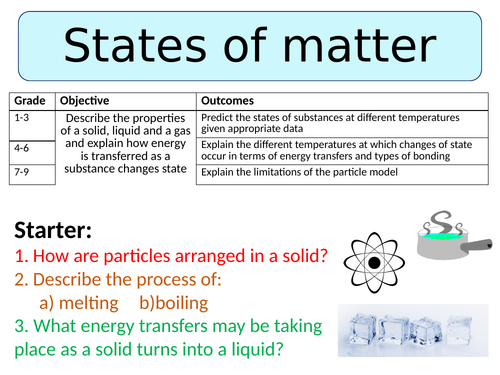
This lesson is designed for the NEW AQA Trilogy Chemistry GCSE, particularly the ‘Structure & Bonding’ SoW.
For more lessons designed to meet specification points for the NEW AQA Trilogy specifications for Biology, Chemistry and Physics please see my shop: https://www.tes.com/teaching-resources/shop/SWiftScience
This lesson begins with a recap on the differences between solids, liquids and gases in terms of the arrangement and movement of particles in each of these states of matter. Pupils complete a card sort activity to assess their knowledge on this topic and they can then self-assess their work using the answers provided.
The next part of the lesson focuses on the transitions between states of matter, pupils are firstly reminding of the definitions of melting point, boiling point and freezing point. They will then watch a video on the the transition between states of matter, they will need to answer a set of questions whilst watching the video. This work can be assessed using the answers provided in the PowerPoint presentation. Using the knowledge from this task pupils can then consider why different substances have different melting/boiling points and why adding impurities to a substance may affect the melting/boiling point of a substance.
The next part of the lesson focuses on energy transfers transfers between states of matter, pupils will firstly label a graph with statements to demonstrate what is happening to a substance as it is heated up over time. Pupils then consider, in depth, what is happening to the particles over this period of time, they can think > pair > share their ideas before the answers are revealed within the PowerPoint presentation using diagrams to illustrate the point. Pupils will then complete a set of questions on energy transfers between states of matter to assess their knowledge on the subject. This work can then be either self or peer assessed using the answers provided.
The last part of the lesson is a task where pupils need to consider the limitations of the particle model of matter, again pupils can discuss in their groups what ideas they have on limitations of the model before some examples are revealed at the end of the presentation.
The plenary task is for pupils to write a twitter message about what they have learnt today, including as many keywords as possible.
All resources are included at the end of the presentation. Thanks for looking, if you have any questions please let me know in the comments section and any feedback would be appreciated :)
Get this resource as part of a bundle and save up to 50%
A bundle is a package of resources grouped together to teach a particular topic, or a series of lessons, in one place.
Something went wrong, please try again later.
Hey I have the same problem, I have payed £12 for the whole resources but now I can't access them, can you please send me the updated ones on annawydra86@gmail.com Thank you
There are some errors on these powerpoints that I have had to change, Oxygen does not have 4 electrons in ts outer shell! Also the video link does not work
HI<br /> I left a review last week on the bonding lessons that I paid £12 for as there were so many mistakes. It has now been taken down and re - uploaded. I can not access it now as it's saying I haven't bought it. This has happened before and you sent me an instagram link to contact you but I don't have instagram. My email kferron74 at yahoo dot co dot uk
Where is the video link? £3 and the resource cannot be used....... not very happy
Report this resourceto let us know if it violates our terms and conditions.
Our customer service team will review your report and will be in touch.
